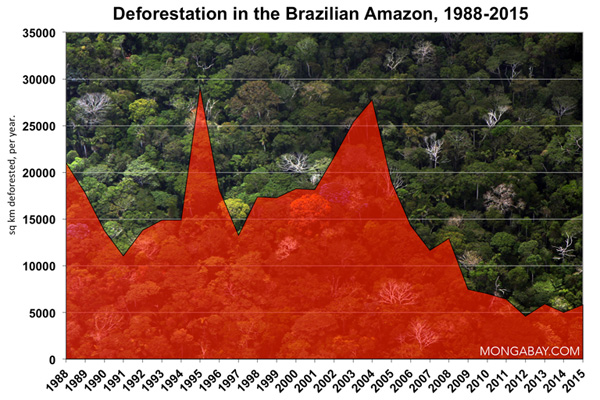Deforestation in the Brazilian Amazon fell to the lowest rate on record, putting Brazil well on track to meet its targets for reducing rainforest destruction.
Analysis of satellite imagery by Brazil’s National Institute for Space Research (INPE) shows that 6,450 square kilometers of rainforest were cleared in the Amazon in the 12 months ended July 31, 2010, a 14 percent drop from the year earlier period.
Speaking in Brasilia, outgoing President Luiz Inácio Lula da Silva said Brazil is meeting its pledge to reduce greenhouse gas emissions.
“We are fulfilling the commitment we have made in Brazil. We will fulfill it because it’s our obligation to do so.”
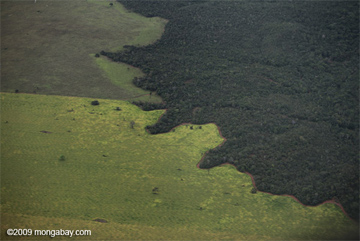 |
In 2009 Brazil passed a law committing the country to reducing greenhouse gas emissions 36-39 percent from a projected 2020 baseline. The bulk of the emissions reductions would come from cutting the the country’s deforestation rate, which until very recently, were the world’s highest. Indonesia now loses more rainforest on an annual basis than Brazil.
In October President Lula announced that Brazil’s 80 percent deforestation reduction target for the Amazon would be met by 2016, four years ahead of schedule.
Brazil’s Ministry of Environment attributes falling deforestation in the Amazon to the Plan for Amazon Deforestation Prevention and Control (PPCDAM), which includes near real-time monitoring of deforestation, increased law enforcement, “regularization” of land titles, and new sustainable development initiatives. The effort has been supported by state governments, civil society and the private sector. For example, municipalities with high deforestation have been “blacklisted”, making it more difficult to receive government support until they implement better controls. Meanwhile major retailers, including Walmart-Brazil and Pao d’Azucar, with the help of environmental NGOs, have implemented traceability systems for beef from the Amazon and signed zero deforestation pacts with suppliers. Major soy producers also have agreed to a moratorium on new deforestation, while the government says a plan to expand palm oil production will mandate strong environmental standards for plantations. Brazil’s progress in reducing deforestation has also been aided by macroeconomic trends, including a strengthening Brazilian real (currency), which makes agricultural products less attractive in overseas markets.
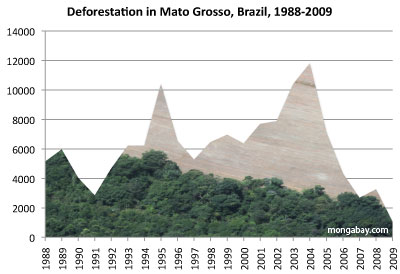 Mato Grosso has experienced the bulk of deforestation in the Brazilian Amazon over the past 30 years. Deforestation figures from INPE. |
But while the trends are positive, concerns remain. BNDES, Brazil’s national development bank, is allocating tens of billions of dollars a year to new Amazon infrastructure projects—including dams and roads—which could increase pressure on forests, both inside and outside Brazil. At the same time, a political movement led by farmers and ranchers is pushing to relax some of the environmental protections established over the past 15 years, including a revision to the forest code, which requires Amazon landowners to maintain 80 percent forest cover on their holdings.
The Brazilian Amazon is also feeling the effects of climate change. This year saw the worst drought on record, which helped spur a large increase in wildfires and a spike in forest degradation in recent months. Climate modelers say drought in the southern Amazon is likely to worsen as sea surface temperatures in the tropical Atlantic rise. Perversely, the western and northern parts of the Amazon may see an increase in rainfall due to climate shifts.
Some environmentalists are further worried that efforts to protect the Amazon rainforest are coming at the expense of the cerrado, the woody grassland where much of Brazil’s agricultural expansion is occurring. Today the cerrado is disappearing at least twice as fast as the Amazon rainforest.
Related articles
Brazil’s development bank announces $588m fund to reduce agricultural emissions
(11/11/2010) Brazil’s national development bank launched a 1 billion reais ($588 million) fund that will finance projects to reduce greenhouse gas emissions associated with agriculture, reports Reuters.
Mato Grosso moves to strip protection of the Amazon rainforest
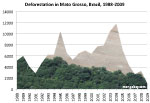
(11/07/2010) The Mato Grosso state assembly passed a bill that would substantially reduce protections for the Amazon rainforest and the Pantanal, a biologically-rich wetland, according to a statement signed by 27 organizations. The bill, which was approved 19 votes to one, would replace the ecological zoning system proposed by the state’s former governor, Blairo Maggi, after three years of consultations with a wide range of stakeholders. The bill reduces areas set aside for conservation by 73 percent and calls for a 67 percent increase in the area zoned for agriculture intensification.
Deforestation falls, but rainforest damage surges in Brazil in Sept
(11/06/2010) Despite the worst drought on record in the region, deforestation in the Brazilian Amazon during September fell by 20 percent relative to September 2009, reports Imazon, a research institute that provides monthly updates on forest clearing.
Brazil’s national development bank found guilty of driving Amazon deforestation
(10/25/2010) BNDES, Brazil’s national development bank, contributed to Amazon deforestation by lending billions of dollars to commercial meatpackers, driving expansion of cattle ranching across the world’s largest rainforest, ruled an audit by the Federal Audit Court.
Amazon suffers worst drought in decades
(10/24/2010) The worst drought since 1963 has created a regional disaster in the Brazilian Amazon. Severely low water levels have isolated communities dependent on river transport. Given a worsening situation, Brazil announced on Friday an emergency package of $13.5 million for water purification, tents, and food airdrops.
Corporations, conservation, and the green movement
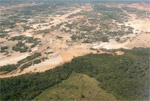
(10/21/2010) The image of rainforests being torn down by giant bulldozers, felled by chainsaw-wielding loggers, and torched by large-scale developers has never been more poignant. Corporations have today replaced small-scale farmers as the prime drivers of deforestation, a shift that has critical implications for conservation. Until recently deforestation has been driven mostly by poverty—poor people in developing countries clearing forests or depleting other natural resources as they struggle to feed their families. Government policies in the ’60s, ’70s, and ’80s had a multiplier effect, subsidizing agricultural expansion through low-interest loans, infrastructure projects, and ambitious colonization schemes, especially in the Amazon and Indonesia. But over the past two decades, this has changed in many countries due to rural depopulation, a decline in state-sponsored development projects, the rise of globalized financial markets, and a worldwide commodity boom. Deforestation, overfishing, and other forms of environmental degradation are now primarily the result of corporations feeding demand from international consumers. While industrial actors exploit resources more efficiently and cause widespread environmental damage, they also are more sensitive to pressure from consumers and environmental groups. Thus in recent years, it has become easier—and more ethical—for green groups to go after corporations than after poor farmers.
Walmart takes on Amazon deforestation
(10/18/2010) The world’s largest retailer last week announced new sourcing criteria for commodities closely associated with deforestation: palm oil and beef from the Amazon.
Concerns over deforestation may drive new approach to cattle ranching in the Amazon

(09/08/2009) While you’re browsing the mall for running shoes, the Amazon rainforest is probably the farthest thing from your mind. Perhaps it shouldn’t be. The globalization of commodity supply chains has created links between consumer products and distant ecosystems like the Amazon. Shoes sold in downtown Manhattan may have been assembled in Vietnam using leather supplied from a Brazilian processor that subcontracted to a rancher in the Amazon. But while demand for these products is currently driving environmental degradation, this connection may also hold the key to slowing the destruction of Earth’s largest rainforest.
Brazil’s plan to save the Amazon rainforest

(06/02/2009) Accounting for roughly half of tropical deforestation between 2000 and 2005, Brazil is the most important supply-side player when it comes to developing a climate framework that includes reducing emissions from deforestation and forest degradation (REDD). But Brazil’s position on REDD contrasts with proposals put forth by other tropical forest countries, including the Coalition for Rainforest Nations, a negotiating block of 15 countries. Instead of advocating a market-based approach to REDD, where credits generated from forest conservation would be traded between countries, Brazil is calling for a giant fund financed with donations from industrialized nations. Contributors would not be eligible for carbon credits that could be used to meet emission reduction obligations under a binding climate treaty.
How to save the Amazon rainforest
(01/04/2009) Environmentalists have long voiced concern over the vanishing Amazon rainforest, but they haven’t been particularly effective at slowing forest loss. In fact, despite the hundreds of millions of dollars in donor funds that have flowed into the region since 2000 and the establishment of more than 100 million hectares of protected areas since 2002, average annual deforestation rates have increased since the 1990s, peaking at 73,785 square kilometers (28,488 square miles) of forest loss between 2002 and 2004. With land prices fast appreciating, cattle ranching and industrial soy farms expanding, and billions of dollars’ worth of new infrastructure projects in the works, development pressure on the Amazon is expected to accelerate. Given these trends, it is apparent that conservation efforts alone will not determine the fate of the Amazon or other rainforests. Some argue that market measures, which value forests for the ecosystem services they provide as well as reward developers for environmental performance, will be the key to saving the Amazon from large-scale destruction. In the end it may be the very markets currently driving deforestation that save forests.
Future threats to the Amazon rainforest
(07/31/2008) Between June 2000 and June 2008, more than 150,000 square kilometers of rainforest were cleared in the Brazilian Amazon. While deforestation rates have slowed since 2004, forest loss is expected to continue for the foreseeable future. This is a look at past, current and potential future drivers of deforestation in the Brazilian Amazon.
